GOLF CHAMPIONSHIPS ON SMGD COURSES:
At Close House – Colt Course. Sept 2017. A prestigious European Tour Championship hosted by Lee Westwood.
Broadcast worldwide from Royal Wellington Golf Club, NZ. October 2017. WOW!
The legacy continues.
Co-hosted at the award-winning Millbrook Resort near Queenstown, NZ. 2014 – 2023.
Bunkers
Since golf began, bunkers worldwide have been for their size, shape, position and personality, disproportionately loathed and loved. Millions of words have been used to describe them. However, like trade winds across the vast oceans, most missed the small sails of accuracy. What are bunkers for, how have they evolved, and what constitutes a good bunker?
The first bunkers were sandy wastes. They could vary in size varying from acres to inches. There was no definition, nor any ruling, simply the ball had to be played from these areas. In the late Victorian era, with golf gaining popularity new rules ensued. Bunkers became classified as ‘hazards’ in the 1891 R&A code. However, the definition was extremely broad. By 1933 the code had evolved to read; ‘A “Hazard” is any bunker, water (except “casual water,”) ditch, sand or road. Sand blown onto the grass, or sprinkled on the course for its preservation, bare patches, scrapes, tracks and paths, snow, ice and casual water are not hazards.’ But this definition also caused great confusion. In places where bunker edges were not clearly defined, and the ball lay on some sand, was the ball in the bunker or not? Interpretation of the rules was difficult and up individual golfers discretion- not a situation the governing authorities liked.
Things had to change, and they did. In 1952 a breakthrough was made when the R&A and USGA issued a joint code modernising the definition of a hazard. It read; ‘A “hazard” is any bunker, or water hazard. Bare patches, scrapes, roads, tracks and paths are not “hazards”. For the courses in sandy waste areas, this required there to be some distinction between ‘bunkers’ and sandy waste areas. St Andrews made the transition. What was originally a course with no defined bunkers, became a course with clearly defined, sod-faced (revetted) bunkers.
 |
 |
 |
Revetted bunkers became one style of design. Many others developed including the low-lying flat bunker, the organic shaped ‘amoeba’ bunker, the deep ‘trough’ bunker, the bunkers with overhanging grasses, the bunkers with islands in them etc. Styles evolved either naturally, serendipitously by the hand of greenkeepers, or purposefully by an architect. Either way, over time styles have become characteristic of certain courses. As a credit to the variety of golf course designs, no one style or bunker type has become more popular than another. Each has its merits and many unique to an area. Indeed, some countries have developed regional variation using indigenous materials, eg New Zealand with the Ponga-faced bunker.
Aesthetics aside, form followed function and the design style of bunkers was to achieve practical goals. E.g. deeper bunkers, are built on windy courses to prevent ‘blow’- a situation where sand is blown across a fairway or green. In very windy sites, architects may even specify a heavier sand to further minimise the chance of blow. In addition, revetted bunkers were invented not to provide greater resistance to erosion on the sandy links.
An accolade some of the most notorious and beguiling bunkers receive for the devastation they have delivered is a name- eg. ‘Hell’ bunker at St Andrews, ‘Hell’s half acre’ at Pine Valley, the ‘Church Pews’ at Oakmont, or the ‘Cardinal’ at Prestwick. For their position and proportion, these bunkers are real hazards that challenge all golfers each time they are faced. They are the sandy icebergs that don’t recognise the calibre of any event or player. And if golf is to maintain its intrinsic fascination, such strong, direct challenges must remain.
 |
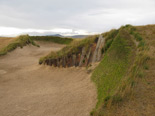 |
 |
Legendary golf architect Donald Ross wrote ‘There is no such thing as a misplaced bunker. Regardless of where a bunker may be, it is the business of the player to avoid it.’ However the placement of a bunker is very important. A well-positioned bunker will make a player think, and I prefer them to be close to the line of play. This way, for a player to get the best line into a green, they must risk being ‘trapped’. On an ideal course, there is sufficient acreage for a golfer who wishes to avoid the hazard to lay up or play around the bunker, but the cost for this evasion may be a longer route to the hole or an extra shot. Bunkers on the direct line of play do not come with out criticism however, but that criticism can be the highest form of commendation, as the bunker is now a conscious hazard to be navigated.
Beyond style and placement, good bunkering has another dimension – they are the purveyors of chance. Should the lie of the ball be good, the penance may be inconsequential, but up against the bunker face and the punishment maybe terminal. Though some modern designs have tried to remove this aspect of golf, such variation is the great virtue of golf because it represents the same unpredictable force that is interwoven into the fabric of life itself. As John L. Low said in 1903, ‘A course should never pretend to be, not is it intended to be, an infallible tribunal of skill alone. The element of chance is the very essence of the game, part of the fun of the game.’
There is a cost consideration to bunkers and what bunker strategy some designers get with many bunkers, better designers may achieve with fewer bunkers, and for this there may be a cost saving.
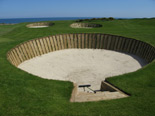 |
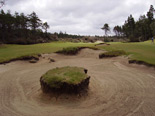 |
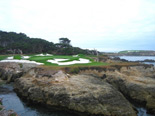 |
Bunkers are the interest, the challenge, the opposition, and the providers of the greatest insight into our golfing personas. Bunkers exist to intimidate, intrigue, and punish golfers and how we react during our sandy incarceration says as much about us as it does about our golfing ability. Where would we be without these vexing ridiculers, these stationary providers of shame and humiliation, these ‘greedy wee enemies’ as golf writer Bernard Darwin described the bunkers at St Andrews? Where would golf be without the opportunity for salvation in the face of purgatory? Lost. Golf would be a sadder game, an easier game and a poorer game. Good golf courses take pride in their bunkers because they know that while the greens may be the face of the course, the bunkers are the soul.
AWARDS
 Winner
Winner
Excellence in Compliance Award
Royal Wellington Golf Club
 Scott awarded by GEO as a Sustainable Golf Champion
Scott awarded by GEO as a Sustainable Golf Champion
PUBLICATIONS
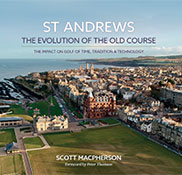 St Andrews
St Andrews
The Evolution of the Old Course
by Scott Macpherson
TESTIMONIALS
"When I was looking for a golf architect I wanted someone who would understand the landscape and have the flair to design a course of the highest quality in terms of; aesthetics, a player's and playing perspective; being practical in terms of forward maintenance; and to bring the construction in on time and on budget. Scott is that man! And what's more he brings competence and professionalism and an easy management style and enthusiasm that is infectious and at no extra charge – a little bit of magic to it all!"
Derek Young, Chairman Kersewell Resort Group, Scotland, UK.



